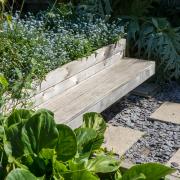Fragrance is a very personal and subtle tool to use to bring another dimension to your garden. Each of us has a unique sense of smell - a long-forgotten scent can stir memories of the past, evoke moods, refresh or soothe us and makes the most beautiful bloom even more enticing. Even the smallest garden may have room for a scented corner, into which you could dot fragrant shrubs and even trees to star at different times of the year. Alternatively, change the fragrances with seasonal containers, adorn an arch to walk through, plant along a path so that those brushing past will release a hidden scent, relish in the range of herbs, or add to existing borders. Choosing the right plants for your garden's conditions can bring fragrance to your garden throughout the year, elevating it to a romantic idyll with scent's invisible delights.

You are often aware of a scent before you come upon the plant; with others you need to bury your face into the bloom, or crush the leaves to release the unseen spirit. Many nostalgic flowers of the past have it over the modern hybrids of today. Whether you have a few window boxes, a potted city courtyard or a country garden, there are choices for all, from scented-leaf pelargoniums to eucalyptus trees. When you select your plants, consider not only their colour, form and suitability to your conditions, but also the extra allure of fragrances that appeal to you. This doesn’t just mean flowers and leaves - fruit, seedpods, bark, roots and buds can also be aromatic. Shrubs, trees, perennials, annuals, bulbs, climbers and groundcovers can be selected for this added asset - just use your nose as well as your eyes when wandering around a nursery or visiting gardens.

There is no set plan to follow, as in essence a fragrant garden is a personal mix of plants chosen with scent in mind. The style of your garden will guide your selection, whether a cottage medley, colour-themed border or naturalistic scheme for example, along with the practicalities of climate, soil, aspect and ease of care. Have a sense of the overall effect you are after and draw up a list of plants you’d love to include that you can then research. Positioning plants in warm, sheltered spots throughout the garden with fragrance at different times allows a continuation year round. White and pastel flowers are among the most fragrant; followed by pale pink, through mauves and yellows to the less scented purples and blue. Orange and scarlet blooms, meanwhile, tend to have more colour than fragrance. Hedging and windbreaks, created using shrubs such as viburnum, offer the opportunity for pockets of still air allowing fragrance to linger, as do low hedges of roses, rosemary or lavender. Placing plants close to the house will allow the aromas to carry inside.

You may be surprised at the range of scents on offer in winter. As we spend less time in the garden in winter, placement is especially important. Plant your sweet-smelling choices where you will get the most benefit. This could be, for example, in garden beds near the front door as you head inside for warmth, or pots on the patio to enjoy on fine days. When visiting gardens still open through the winter hunt out some options. Kent has an array of inspiring National Trust properties to visit in every season. At the atmospheric Scotney Castle, a romantic garden at any time of the year, look out for some wonderful choices. By the house itself, at the blue gate into the garden, you’ll find Sarcococca confusa or sweet box, named for its sweet honey-like fragrant winter flowers. Skimmia x confusa ‘Kew Green’ is used in shady spots for its dense clusters of very fragrant creamy-white winter-to-spring flowers. A stalwart of the winter garden for its heady fragrance from clusters pale pink flowers that you may smell even before seeing, Daphne bholua ‘Jacquelling Postill’ is also a great choice for small gardens, as it can be grown in garden beds or containers.

At many of the National Trust properties you’ll spot the first of the snowdrops, dwarf irises and carpets of winter aconites. These dainty beauties also have a subtle scent. You’re sure to find further ideal choices for your garden, including mahonias with their spires of scented golden blooms, the very fragrant winter honeysuckle blooms held on nearly bare branches, varieties of viburnum, and stunning witch hazels with their spidery yellow, orange or pink flowers ablaze in the sunshine. All these will thrive not only in the garden but also in containers, as will herbs such as sage and rosemary, which release their aromatic oil when you brush against the foliage. Once you have identified some lovely plants to try I’d recommend visiting your local garden centre where you can take down the potted plants that appeal individually, group them together and check the aromas are pleasing to you and in combinations, so as not to overwhelm or muddy the scents.

Top 5 winter-scented plants
• Chimonanthus praecox, wintersweet, is a must have for its translucent blooms of the most delicate but powerful fragrance. Needs a sheltered sunny spot, such as against a warm wall. One sprig in a vase inside will fill a room with its delicious scent
• Hamamelis, witch hazels, are invaluable deciduous small trees and shrubs in the winter garden, for both colour and a bewitching scent from their spider-like textural yellow, orange, red or pink flowers. They like sun to part shade in any moist, well-drained soil. Great as a specimen focal point, lining a path, in a mixed winter border, and underplanted with early spring bulbs. Hamamellis x intermedia ‘Vesna’ is one of the best.
• Sarcococca confusa, Christmas or sweet box, is an easy care rounded evergreen shrub with dainty creamy white vanilla-scented flowers, from December to March, amongst leathery green leaves. Suitable for a sheltered spot in fertile, well-drained soil, in part to full shade so great for shady borders, low-maintenance areas, hedging and containers.
• Mahonias are a great choice for winter colour and scent with spires fragrant yellow flowers from October to spring. Evergreen and very hardy, low maintenance and thrive in shade to full sun in moist, well-drained soil.
• Daphnes have intensely fragrant blooms and their compact nature makes them perfect for sheltered, small gardens and also containers. Grow them in part shade in neutral to slightly alkaline soil that is free-draining.
To know
• The National Trust, Web: nationaltrust.org.uk
• Witch Hazel Nursery, Sittingbourne, ME9 7LU
Open days in January, see website, Web: witchhazelnursery.com



























